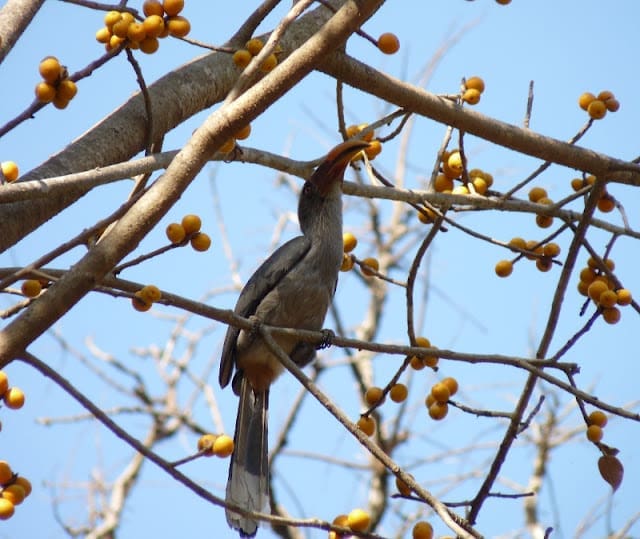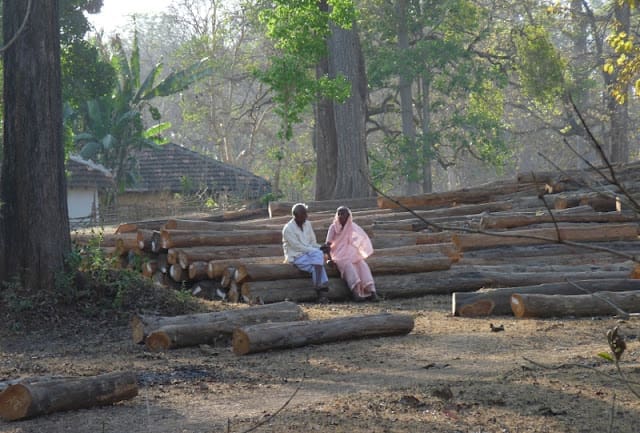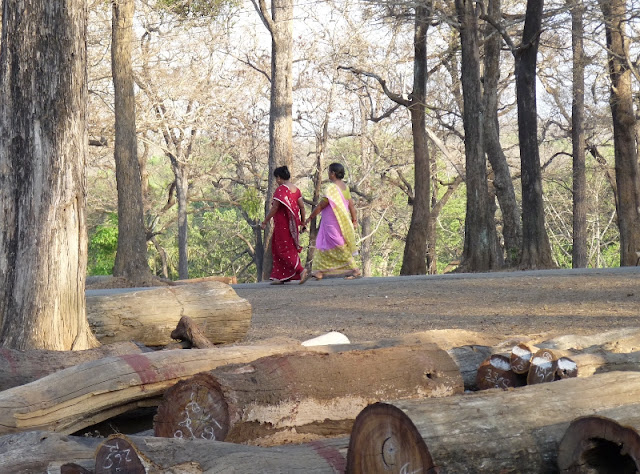If a man walks in the woods for love of them half of each day, he is in danger of being regarded as a loafer. But if he spends his days as a speculator, shearing off those woods and making the earth bald before her time, he is deemed an industrious and enterprising citizen.
– Henry David Thoreau
The Timber Depot at Dandeli is a living graveyard, if that oxymoron makes any sense. It stands right in the heart of this sylvan north Karnataka town, which the virile Kali river cleaves in two as it hurries to the sea about a hundred kilometres away at Karwar. One hot afternoon in April, we crossed a bridge over the river (gawking at the heft of an enormous marsh crocodile basking on an islet) and arrived at the timber depot. We had barely entered when it struck us that this place had more hornbills than we had collectively bargained for.
 |
| An enormous mugger basks in the afternoon sun beside the swollen Kali river |
 |
| A Malabar Grey Hornbill takes a burp break |
The evening light softened the mood, lending to the recumbent logs a sobering burnish. Above me, the canopies were aflutter with so much avian activity that I had trouble deciding where to look. We were just recovering from the surfeit of Malabar Pied Hornbills, which were ubiquitous, and gazing with satiated boredom upon flocks of Malabar Grey Hornbills. Glossy-black male Asian Koels and their speckled mates, White-cheeked and Coppersmith Barbets, Plum-headed Parakeets, Pompadour Green Pigeons and Chestnut-tailed Starlings feasted on the cornucopia of yellow fruit, barely shuffling at the disturbance caused by our gawking selves.
 |
| A female Pompadour Green Pigeon makes love to its meal |
 |
| A Coppersmith Barbet appears to be lost in thought before it takes another bite |
Against the relentless symphony of cicadas an Indian Roller sallied about, flaunting its brilliant cerulean hues in vain as we ignored it for the hornbills. A troop of Hanuman Langurs, comprising overgrown adult males, subadults and females with infants, pillaged the trees of fruit and leaves. Giant squirrels stuffed their mouths. Mynas and crows hung around, unable to resist the opportunity to dig in.
What was this manna that got the entire animal kingdom in raptures, I wondered. I picked up a fallen fruit and bit into it. It was tough-rinded but juicy, not sweet but leaning towards sour, and otherwise unremarkable. It left an acidic aftertaste. I spat it out.
 |
| A pair of Malabar Giant Squirrels were delightful to watch as they ate meditatively in the canopy |
Yet, with so much to behold, the trees and their supine carcasses haunted my thoughts. Did this charming evening spent at this necropolis signify something more: perhaps the oncoming eventide for all of our great old-growth forests and their guardians, the hornbills?
The sleepers that lived and died wait, the far advanced
are to go on in their turns, and the far behind
are to come on in their turns,
The diverse shall be no less diverse, but they shall
flow and unite
–they unite now.
Gluttony in the Timber Graveyard from Green Ogre on Vimeo.
From Sleepers by Walt Whitman
- TL;DR – Death Stalks Like A Marabou Stork - July 24, 2024
- Dimorphic Egret – Meet this East African mystery bird - June 8, 2024
- Encounter: Northern Treeshrew in Arunachal Pradesh - May 19, 2024





